Secrets of Writing a Book Description that Sells (With Examples & Templates)
With the countless number of books that get published every year, all competing for attention, it’s usually the book description that possesses the power to captivate potential readers and compel them to make the purchase. And while the book cover and title may initially raise their interest, it is that captivating description that seals the deal.
By creating a well-crafted book description, you’ll be able to intrigue your readers’ curiosity and evoke their emotions. But in order to achieve that, you need to understand what exactly goes into writing a creative yet professional description for your book, and maybe check some bestselling books for inspiration. And that’s exactly what we’ll cover in this article.

What Is a Book Description?
A book description is a short and exciting summary of your book that highlights its best parts to grab readers’ attention and make them want to buy it. A well-written book description gives the readers a sneak peek into the story and gets them interested in reading the rest of the book. Along with your book title, cover, and price, the description can be a great marketing tool for converting potential readers into buyers.
The Importance of Book Description
There are many reasons why you should care about perfecting your book description. Not only does it have the power to convert potential readers into buyers, but it can also affect the following:
- Conversion: Let’s say you’re going to an interview with a great resume and you’re well-dressed, but the first words that come out of your mouth aren’t what the interviewer is looking for, they probably won’t be interested in hiring you. The same would happen if you have a great title and book cover, but your description is poorly written; chances are no one is going to be tempted to purchase and read your book.
- Visibility: Your book description should be SEO optimized to help readers find what they’re looking for (we’ll discuss this in more detail later in the article). This can be done by including certain keywords that you know your potential readers are searching for. Let’s say, for example, that you’re writing a cookbook for beginners called “The ABCs of Grilling”; while the title might be catchy, your target audience might not be searching for “ABCs of Grilling” and instead searching for “grilling guide” in their search engines. That’s why it’s always advisable to use these kinds of related keywords in your book description to reach your target audience.
- Uniqueness: What could possibly differentiate your book from every other book in the same genre? Your book description should. Because even if your title is catchy enough, the description usually gives the reader an idea of what your book is about and how different it is from similar ones in the same genre.
Book Description vs Book Blurb
Since they can be pretty similar, many people get confused between a book blurb and a book description, often using the two terms interchangeably. And while both should be compelling and catchy, there are a couple of differences between them, such as:
- Placement: While a book description appears on the book purchasing online page on the digital publishing platform it’s published on, the blurb is written on the book’s back cover.
- Word Count: Usually a book blurb is between 150 and 200 words. The book description can be an expanded version of the blurb that is a little more than 150 words.
- Target: The book description is crafted with online shoppers in mind, while the blurb usually targets shoppers in physical bookstores and libraries.
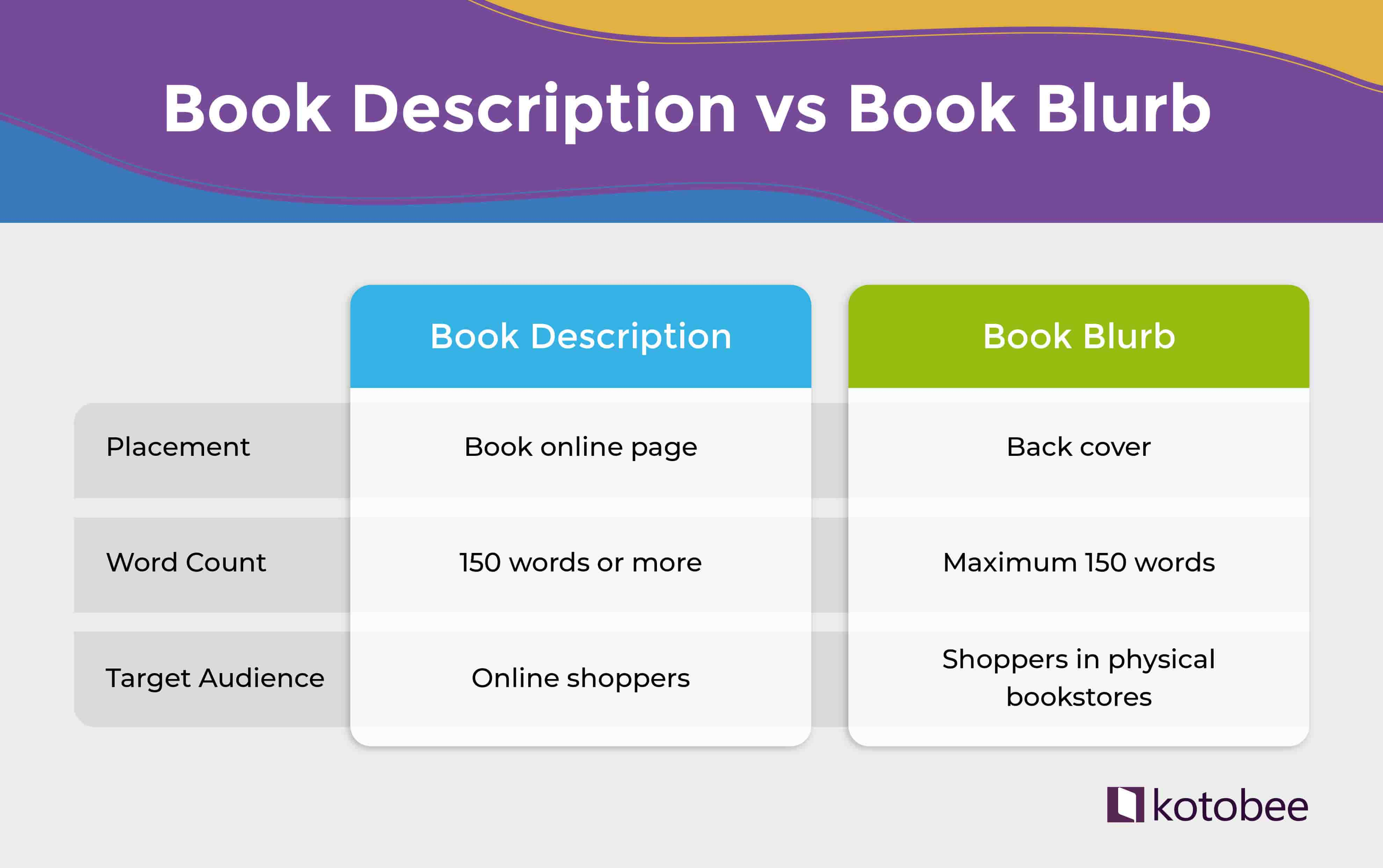
How to Write a Book Description
Now that you know the importance of writing a captivating book description, let’s look at how you can actually create one. Below, we have divided the process into a few simple steps so you can master one after the other. But before going into the details of each step, please note that you don’t have to apply all of them; just include whatever feels right for your own book.
1. Headline
While not every book description has to start with a headline (or a small phrase about the book), it is a sure way to make a quick, powerful impression. Some platforms, such as Amazon, allow you to start your book description with a headline to hook your potential readers.
Usually, the headline is about 25 words or less, written in bold and followed by a paragraph break so it can stand out from the rest of the book description. And it could be anything that can grab your readers’ attention, such as:
- Awards you have won;
- Your book’s genre;
- Key topics your book discusses; or
- Editorial reviews.
While writing this headline, try to show instead of just telling. For example, if your book is a yoga guide for beginners, don’t just write “Learn how to do yoga like a pro;” instead, you can go with something like, “An interactive ebook where you can actually see your yoga instructor and follow their lead every step of the way.”
2. Explanation (without Spoilers)
Whether it’s a fiction or a non-fiction book, you don’t want to give away too much in your book description. And now that you’ve hooked the readers with the headline, it’s time to give them some more details. Think about the details that would get your readers most excited and interested in your book.
As for fiction books, the conflict is what gets the readers invested in the story. Many stories have one main conflict that drives the plot. Even if there’s more than one conflict, one of them tends to take over the flow of events. Try to briefly describe this conflict in an emotionally provoking way that gets your potential readers’ invested in the story.
In non-fiction books, on the other hand, you want to focus on the problems your book solves for your readers. Try answering the following questions: what are the pain points that you’re addressing how does your book help in overcoming them?
3. Relevant Keywords
It’s very important to include the keywords in your description that your potential readers are using to search for books like yours; otherwise, they might not be able to find your book at all. With that in mind, remember that it’s also important not to stuff your book description with many keywords; only keep the relevant ones.
To find the perfect keywords for your book description, you can use tools such as Ahrefs or Keyword Tool, where you can select the language and country you want to target.
For fiction and non-fiction books alike, your keywords could be:
- The genre or subgenre of your book (romance, sci-fi, self-help, economics, etc.);
- Major themes (self-discovery, friendship, grief) or topics (time management, diet, etc.);
- Awards (NYTimes Bestseller); or
- Previous books.
4. Formatting
Using the right format in your book description can be very powerful for readers who are in a hurry and don’t want to go through every single word, especially if it’s just one bulky paragraph. So try implementing these formatting elements to make the text scannable and make it easier for the reader to understand what the description is about:
- Bold
- Italic
- Underline
- Paragraph breaks
- Bullet points
- Large font
It’s worth mentioning, however, that overusing any of these elements can make the description look unprofessional. So use them wisely to help the readers understand what your book is about.
5. Author Credentials
While the book description should focus mainly on the book and not on you, it wouldn’t hurt to mention what makes you qualified for writing this book. This could be anything related to your book, like any awards you’ve won or degrees you have.
Adding your credentials can help paint you as a subject matter expert in the topic of your book. This, in turn, can increase the readers’ trust and confidence in what you wrote, especially for non-fiction books.
6. Testimonials or Endorsements
You can also add any testimonials or endorsements you received from other readers or well-known figures. Testimonials are usually a brief summary of your book by someone who has enjoyed reading it or found it helpful. An endorsement, on the other hand, is usually written by someone who is a subject matter expert, saying that you’re indeed qualified to write this book.
7. Comparative Titles
It’s a good idea, especially if you’re a new author, to add some comparative titles in your book description. This can help indicate the tone and genre of your book, and make your potential readers find it more relatable.
If your book is a crime mystery, for example, you can add something like, “In the tradition of Murder on the Orient Express, this book takes you on a journey where all the suspects are related, and the truth is buried.”
8. End with a Cliffhanger
Just like how you started your description with a hook, you want to end with a cliffhanger that would leave your readers wanting more. This is especially true for fiction books and novels.
The same thing can be applied to non-fiction in the form of a call to action; after hooking the readers with the headline and touching upon their pain points, you can urge them to buy your book to know how to overcome such problems.

Book Description Examples from Best-Selling Books
Looking at book descriptions written for best-selling books can give you an idea of what grabs readers’ attention and push them to purchase these books. You can do that by browsing websites such as Goodreads or Amazon and searching for books in your genre.
To make things easier for you, we’ll present a couple of examples for book descriptions of both fiction and non-fiction books, and show you how famous authors used each part of the description in a smart and captivating way.
1. Non-Fiction Book Description Example
Written by Malcolm Gladwell, The Tipping Point was an instant bestseller for many reasons. Looking at its book description, you can see how it starts with a hook, moves to a spoiler-free explanation, and concludes with an endorsement from another famous writer. It also makes good use of formatting options, such as making the title bold and adding quotation marks.

Another great example is the book description of Atomic Habits, one of the all-time best-selling books. Its description starts with an attention-grabbing, bold title, uses paragraph breaks, and contains bullet points that highlight the main takeaways.
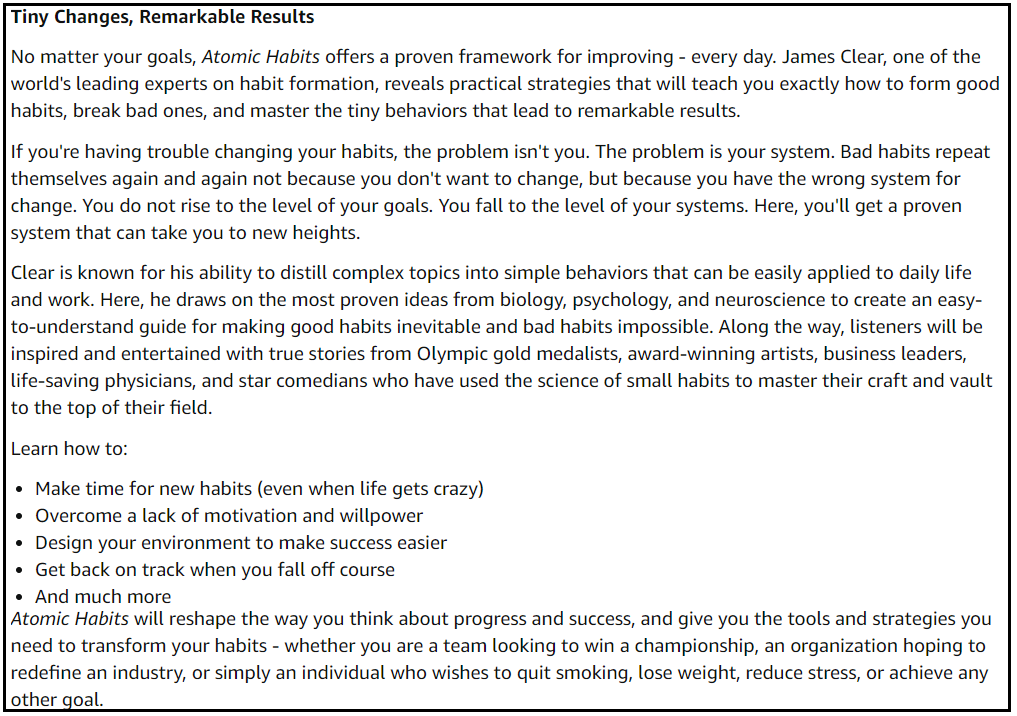
2. Fiction Book Description Example
Now let’s look at a description of fiction books, which might be slightly different than non-fiction ones in that it doesn’t have takeaways or lessons. Still, the descriptions of bestselling fiction books tend to paint a picture of the story and highlight the main themes.
Here’s the description of All the Light We Cannot See by Anthoney Doerr, which also starts with a headline, highlights the author’s credentials, then explains the storyline in an engaging way.
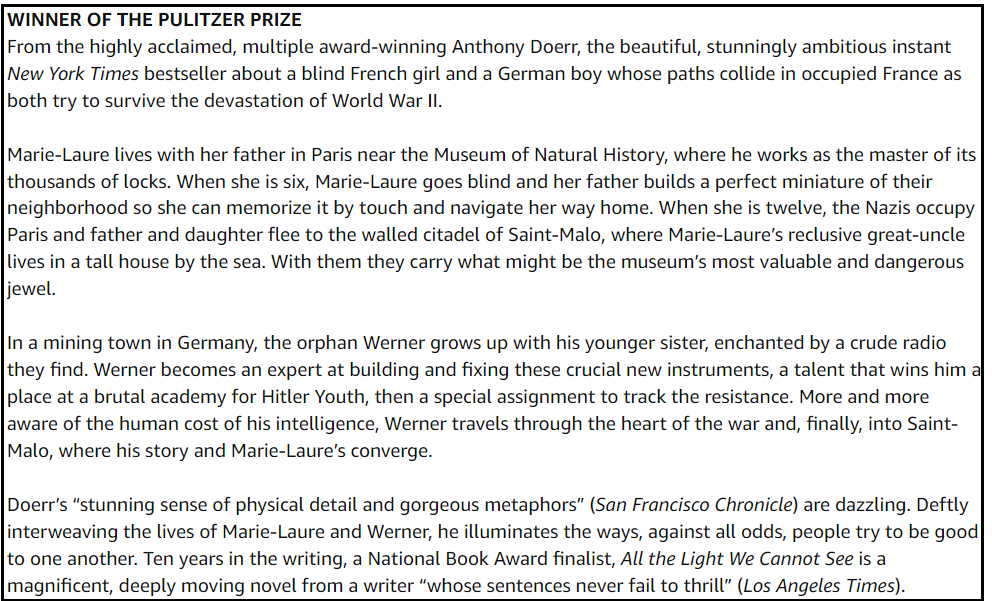
Book Description Template
To make the process of writing a book description easier, we have added below a couple of templates that you can use for your book, instead of creating one from scratch. Whether you need it as a fiction or a non-fiction book, we’ve got you covered.
1. Non-Fiction Book Description Template
Start with a catchy title, a few words that captivate your reader and urge them to continue reading the book description.
Describe the main message of your book in a few, scannable sentences using power words. Touch upon the pain points your readers face and briefly explain how your book helps resolve them. Make sure to use bold, italic, and underlining to highlight the important parts of your description.
Start listing the main topics or takeaways from your book. Write something like, “In this comprehensive guide you will learn”:
– Takeaway #1 and how it’ll benefit them
– Takeaway #2 and use some trigger words
– How reading this book will help them in the long run
You can close by adding a testimonial, endorsement, or a strong call to action.
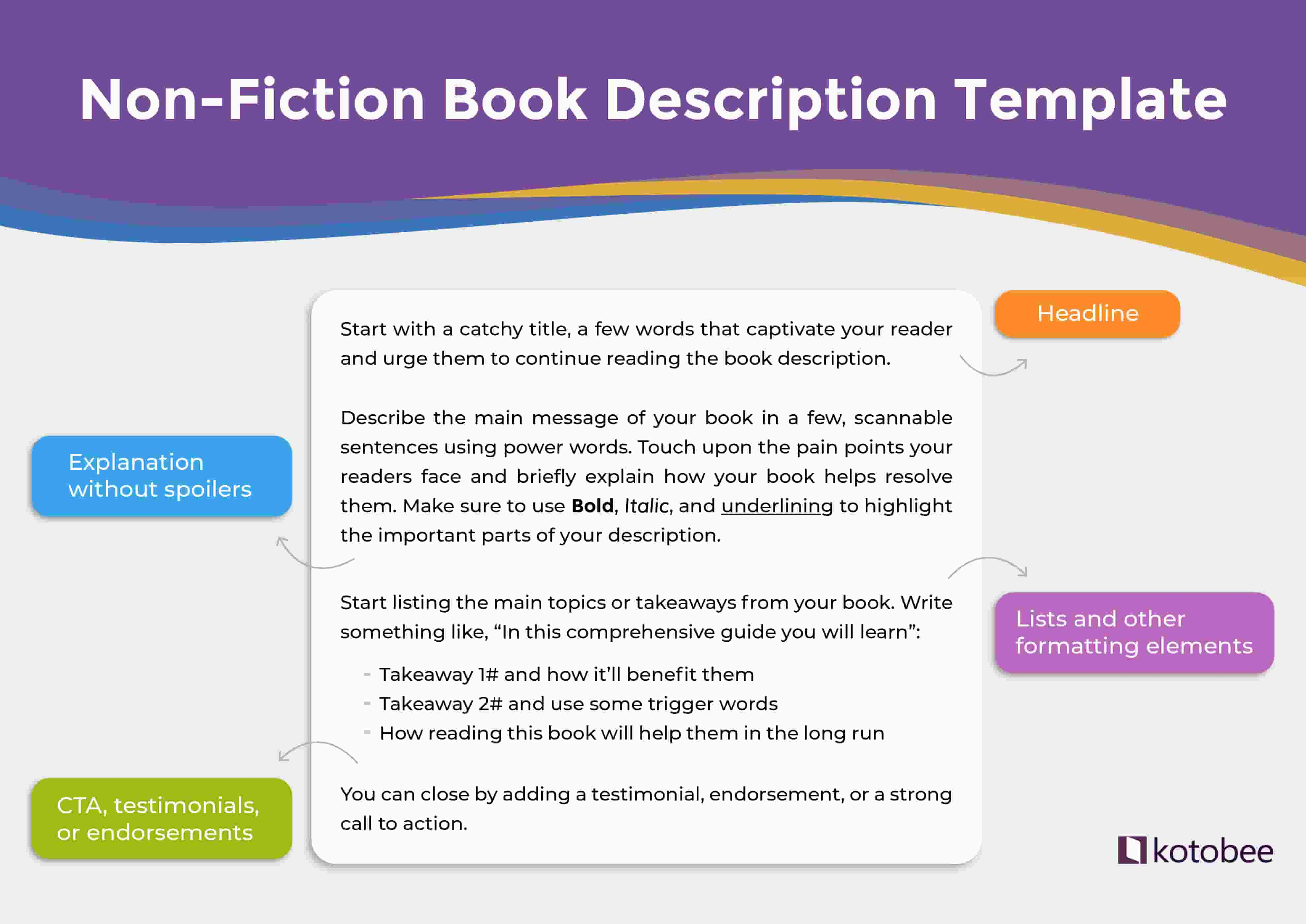
2. Fiction Book Description Template
Start with a title that hooks the readers and makes them want to continue reading the description.
Then you can start describing the setting of your story, including the time, place, and genre.
Move on to the main character of your story and their role in the plot. Describe their journey briefly and make the reader empathize with them.
Use power words to show the reader why this story matters. highlight the main themes of your story and use formatting elements such as bold, italic, and underlining.
Add some comparative titles that are familiar to your target audience. This can be books, shows, or movies. You can also add here a sentence or two about your credentials and any awards you’ve won.
End with a cliffhanger, leaving the reader wanting to know more about the journey of the main characters of your story.
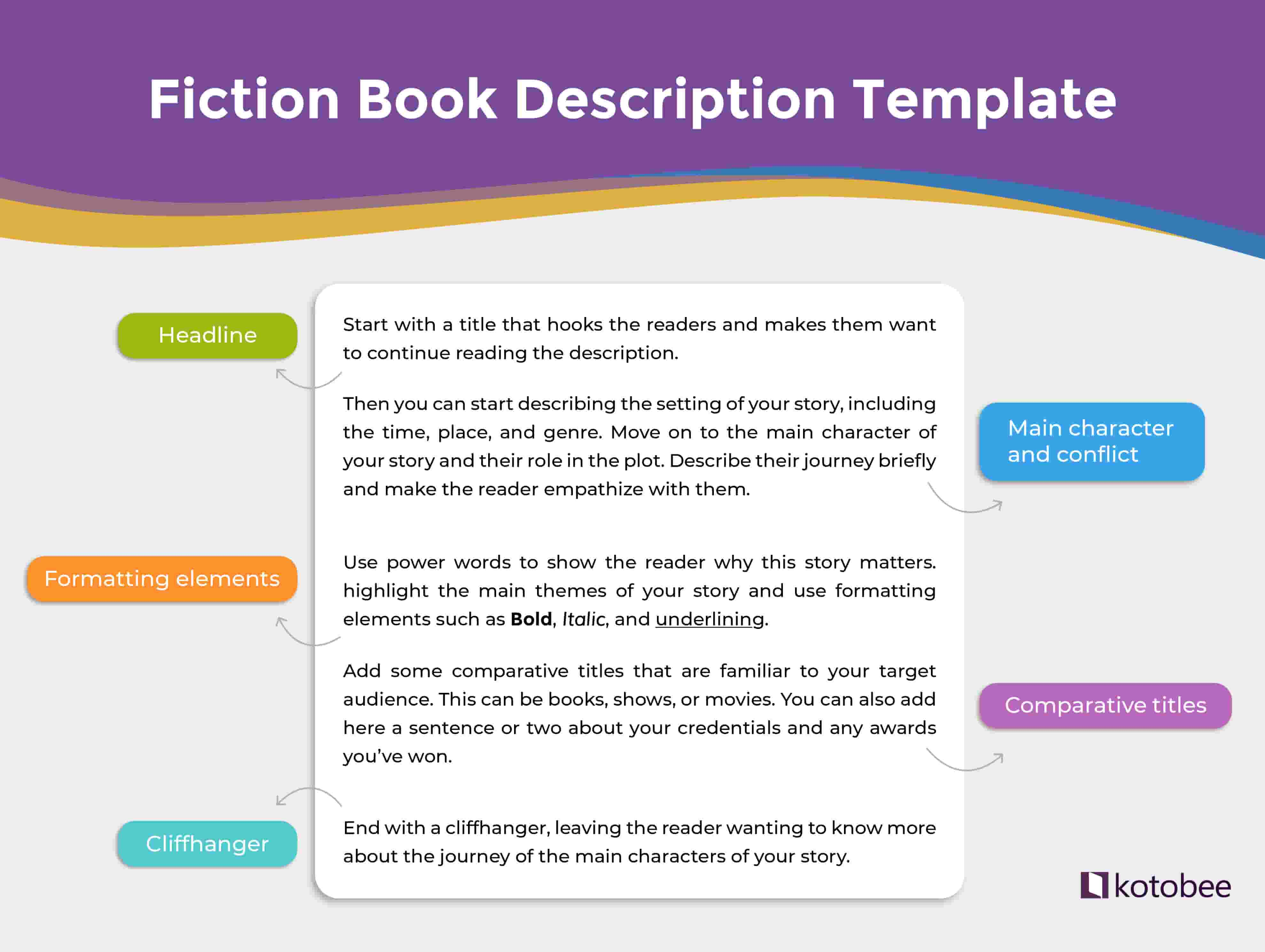
Book Description Generator
If you feel that all the previous steps are too much, then you can definitely use a book description generator to write one for you. And while we recommend that you rely more on the human touch, you can always edit and tweak the results that come from these generators to be more to your liking.
Here are some book description generators that can help you get the job done:
- Nichesss: This website offers over 150 advanced AI tools to help writers with different aspects of the writing process. Their free book description generator can create different ones in a matter of seconds. All you have to do is type a short description of what your book is about and the title of your book, then choose whichever option you feel is the most captivating.
- Paraphrasing Tool: While this is mainly a paraphrasing tool, you’ll find many other useful AI writing tools, including a free book description generator. It allows you to enter your book title and one or two sentences explaining what your book is about. It then proceeds to generate a captivating description that you can use on your book page.
- Kindleprenuer: If you have been looking for how to write a book description for Amazon, then this tool is perfect for you. Instead of writing the description for you, this tool helps you get a formatted HTML that you can copy and paste to your book description page on Amazon, among other platforms.
- Book Raid: Unlike the other tools, this one doesn’t just write your book description for you. While it can do that, giving you a beautifully tailored description for your book page, it also has a couple of other options that can help you market your book to the right audience. The first is categorizing your book, suggesting the genre and sub-genre you can enlist your book under; and the second is highlighting the main themes in your book so you can write a better book description.
How to Add Your Book Description in Kotobee
Now that you know how to write your book description, let’s see how you’ll add it to your ebook in Kotobee Author. Here’s all you have to do:
- Open the Book Manager from the Edit screen.
2. Then paste your book description in the field labeled Description. Click OK and you’re done.

Wrapping Up
A compelling book description can be a powerful marketing tool that hugely affects your book sales. By applying the tips we shared in this article, you’ll be able to get the readers’ attention with a concise yet emotionally engaging description that has the potential to convert them into buyers.
So roll up your sleeves and start crafting your description, and maybe even try to create multiple drafts until you find the perfect fit. And if you ever need assistance, keep in mind that numerous description generators are available to lend a helping hand in getting the job done.
.
Read More
How to Write a Book Title: Practical Tips for Authors











